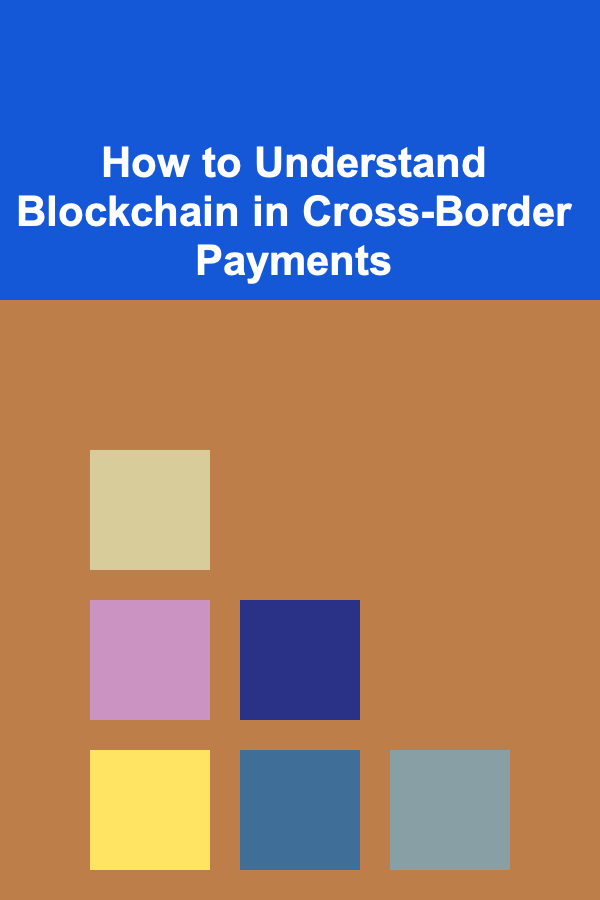
How to Understand Blockchain in Cross-Border Payments
ebook include PDF & Audio bundle (Micro Guide)
$12.99$9.99
Limited Time Offer! Order within the next:

The rise of blockchain technology has been one of the most transformative developments in the financial world in the last decade. Blockchain, known for its association with cryptocurrencies like Bitcoin, has garnered attention far beyond digital currencies. One of its most promising applications lies in the realm of cross-border payments, a space plagued with inefficiencies, high costs, and complexities. Understanding how blockchain can revolutionize cross-border payments requires a deep dive into both the technological and economic aspects of the solution it proposes.
The Problems with Traditional Cross-Border Payments
To understand how blockchain can improve cross-border payments, it's essential to first grasp the issues with the current system. Cross-border payments have long been a challenging area for both individuals and businesses due to several factors:
- High Fees: Traditional cross-border payment systems, such as those used by banks and money transfer services, often charge high fees. These fees are not just associated with the transfer itself but also with the intermediaries involved in the process, such as correspondent banks.
- Time Delays: Transactions can take several days to process, especially when they involve multiple intermediary banks. These delays are exacerbated by differing time zones, bank hours, and the complex clearing processes required for international money transfers.
- Lack of Transparency: The traditional system is often opaque, with little visibility on the status of transactions. This can create uncertainty for both senders and recipients, especially when it comes to issues like hidden fees or exchange rate fluctuations.
- Inaccessibility: Many people around the world, particularly in developing regions, still lack access to the financial system. Cross-border payment services may not be available or may be prohibitively expensive for these populations.
- Security Risks: Traditional systems are often vulnerable to fraud, data breaches, and other security risks. The reliance on centralized intermediaries increases the risk of single points of failure.
Blockchain offers a potential solution to these challenges, providing a decentralized, secure, and efficient system for cross-border payments.
What is Blockchain?
At its core, blockchain is a distributed ledger technology (DLT) that enables secure, transparent, and immutable transactions. It works by recording transactions on a decentralized network of computers, or nodes, rather than relying on a central authority like a bank. This decentralized nature provides several key advantages:
- Decentralization: No single entity controls the network, reducing the risk of fraud or manipulation.
- Transparency: All transactions are publicly recorded on the blockchain, making them transparent and auditable.
- Security: Blockchain uses cryptographic techniques to secure transactions, making it highly resistant to tampering.
- Immutability: Once a transaction is recorded on the blockchain, it cannot be altered, ensuring the integrity of the data.
Blockchain can be used for various applications, but one of the most promising is in the realm of cross-border payments.
How Blockchain Transforms Cross-Border Payments
The integration of blockchain technology into cross-border payments promises to address the inefficiencies of traditional systems. Here's how it works:
- Direct Transactions: Blockchain allows for peer-to-peer transactions without the need for intermediaries like correspondent banks. This eliminates the need for multiple steps in the transfer process, significantly reducing both time and cost.
- Lower Fees: By removing intermediaries, blockchain-based systems can drastically reduce the fees associated with cross-border payments. This is particularly beneficial for businesses and individuals who frequently send money across borders, as it lowers the overall cost of international transactions.
- Faster Settlements: Blockchain enables real-time settlement of transactions. Unlike traditional systems, where payments can take several days to settle, blockchain transactions can be completed in minutes or even seconds, depending on the network.
- Increased Transparency: Blockchain's transparent nature allows for full visibility into the transaction process. Both the sender and the recipient can track the status of their payment in real time, ensuring that there are no hidden fees or unexpected delays.
- Access for the Unbanked: Blockchain technology can help bring cross-border payment services to individuals who are excluded from the traditional banking system. With just a smartphone and an internet connection, people in remote or underserved regions can send and receive payments, enabling financial inclusion.
- Enhanced Security: Blockchain's cryptographic security features make it much harder for transactions to be hacked or manipulated. This is a significant improvement over traditional banking systems, which are often vulnerable to cyberattacks and fraud.
Key Blockchain Solutions for Cross-Border Payments
Several blockchain-based solutions are already being developed and implemented to streamline cross-border payments. These solutions aim to tackle the inefficiencies of traditional systems and provide a more secure, cost-effective, and efficient way to transfer money internationally. Some of the most notable blockchain solutions for cross-border payments include:
1. Ripple (XRP)
Ripple is one of the most well-known blockchain-based payment platforms. Ripple's network allows for fast and low-cost cross-border payments by connecting financial institutions through a decentralized ledger. Ripple's native cryptocurrency, XRP, is used as a bridge currency, enabling seamless conversions between different fiat currencies.
Ripple's key features include:
- Fast Transactions: Ripple can settle payments in just a few seconds, compared to the several days it typically takes with traditional systems.
- Low Fees: Ripple's fee structure is significantly lower than traditional payment systems, making it an attractive option for financial institutions and businesses.
- Liquidity Solutions: Ripple offers liquidity solutions for financial institutions, enabling them to source liquidity from a pool of funds to facilitate international transactions.
2. Stellar (XLM)
Stellar is another blockchain platform designed to facilitate cross-border payments. Unlike Ripple, which focuses primarily on financial institutions, Stellar is designed to provide a decentralized and scalable solution for both individuals and institutions.
Key features of Stellar include:
- Interoperability: Stellar's network can connect different financial systems, allowing for easy exchange of value across borders.
- Low-Cost Transactions: Stellar's transaction fees are minimal, making it ideal for remittance services and small-scale transactions.
- Access to the Unbanked: Stellar focuses on providing access to financial services for the unbanked and underbanked populations, especially in emerging markets.
3. Bitcoin (BTC)
Although Bitcoin is primarily known as a digital currency, it can also be used for cross-border payments. Bitcoin's blockchain offers the advantage of decentralization and security, but it faces challenges in terms of scalability and transaction costs. However, innovations like the Lightning Network are addressing these issues by enabling faster and cheaper Bitcoin transactions.
4. Ethereum (ETH)
Ethereum, the second-largest cryptocurrency by market capitalization, offers a more flexible blockchain platform compared to Bitcoin. Ethereum enables the creation of smart contracts, which are self-executing contracts with the terms of the agreement directly written into code. These smart contracts can be used to automate and streamline cross-border payment processes.
Ethereum's ability to support decentralized applications (dApps) and smart contracts has made it an attractive platform for a wide range of financial services, including cross-border payments.
Challenges and Considerations for Blockchain in Cross-Border Payments
Despite the numerous advantages, there are still challenges to widespread adoption of blockchain in cross-border payments:
- Regulatory Uncertainty: Governments and regulators are still grappling with how to classify and regulate blockchain-based payment systems. The lack of clear regulations in many countries can create uncertainty for businesses and consumers alike.
- Scalability: While blockchain technology has made significant strides in terms of speed and efficiency, some networks still face challenges in processing a large number of transactions simultaneously. Scaling blockchain solutions to handle the volume of global cross-border payments remains a key challenge.
- Volatility: Cryptocurrencies like Bitcoin and XRP are often subject to significant price fluctuations. This volatility can make it difficult for businesses and individuals to rely on blockchain-based payments for daily transactions, particularly if the value of the currency fluctuates dramatically.
- Adoption and Integration: The integration of blockchain technology into existing financial systems and infrastructure can be complex. Many financial institutions are hesitant to adopt blockchain due to concerns about the potential disruption to their existing business models.
- Security and Privacy: While blockchain technology is inherently secure, it is not immune to cyberattacks. The increasing use of blockchain in cross-border payments raises concerns about the security of personal data and financial information on public blockchains.
Conclusion
Blockchain technology has the potential to fundamentally change the way cross-border payments are made. By eliminating intermediaries, reducing fees, speeding up transactions, and improving transparency, blockchain offers a more efficient and secure alternative to traditional systems. Platforms like Ripple, Stellar, and Ethereum are already paving the way for a decentralized and inclusive financial ecosystem, which could bring significant benefits to businesses and individuals around the world.
However, there are still challenges to overcome, particularly in terms of scalability, regulatory frameworks, and volatility. As blockchain technology continues to evolve and gain traction, it is likely that its role in cross-border payments will continue to grow, offering a glimpse into the future of global financial transactions.

How to Choose Reliable Wholesalers for Your Dropshipping Business
Read More
How to Create a Capsule Wardrobe for Easy Outfit Selection
Read More
How to Keep Your Home Looking Beautiful and Tidy During the Holidays
Read More
How to Set Up an Online Craft Store on Etsy or Shopify: An Actionable Guide
Read More
How to Turn Your Entryway Into a Welcoming Space Without Spending Much
Read More
How to Create a DIY Arduino-Powered Weather Station
Read MoreOther Products

How to Choose Reliable Wholesalers for Your Dropshipping Business
Read More
How to Create a Capsule Wardrobe for Easy Outfit Selection
Read More
How to Keep Your Home Looking Beautiful and Tidy During the Holidays
Read More
How to Set Up an Online Craft Store on Etsy or Shopify: An Actionable Guide
Read More
How to Turn Your Entryway Into a Welcoming Space Without Spending Much
Read More